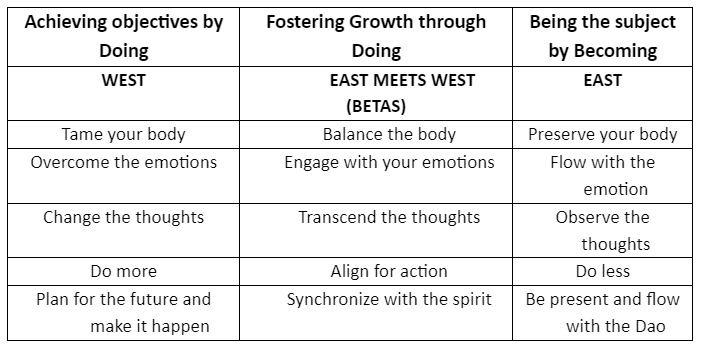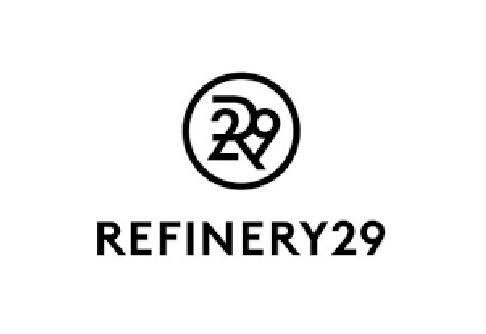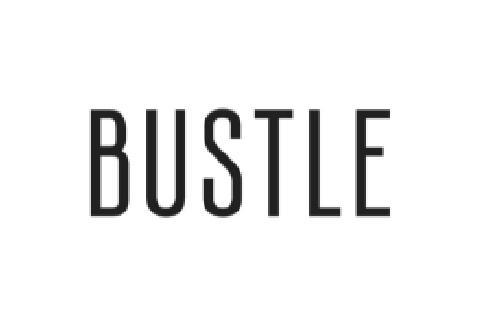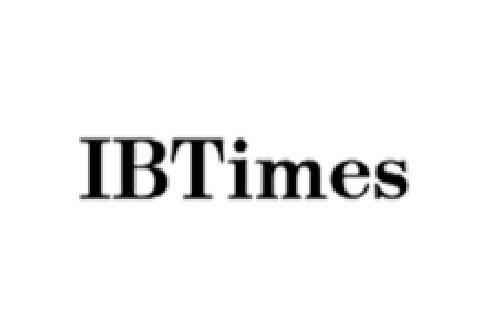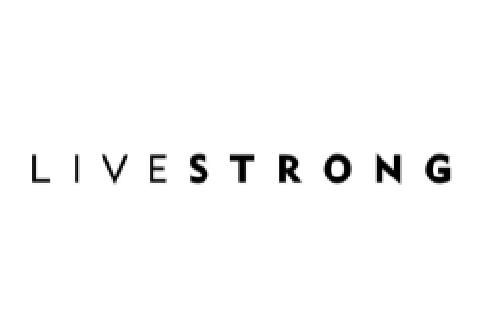I grew up in Asia, completed my education in Europe, and made my home in America. Throughout my life, I could always reflect on stark differences in approach to human dilemmas, differences that often divide the West from the East.
They don’t have to. I strongly believe in the ‘both-and’ approach, and rather than fusing the oriental and the occidental, it is possible to draw the best lessons from each background. In my view, coaching would strongly benefit from this approach.
The Evolution of Coaching
Life coaching evolved in the West, partly in opposition to psychodynamic analysis that focused on the patient’s past (often a distant past). Coaching, by contrast, centers on explicit goal setting and goal pursuit. The pathway towards the precisely delineated goal can be measured – by the speed with which the goal is achieved, by the economy of resources used, and by the overall efficiency and productivity level attained during the process.
However, this single-minded goal focus often turns into an obsession. And this brings a dual dilemma that Western coaching is at pains to address. First, it is an unheralded skill to appreciate what has already been achieved. Many people, having reached a milestone, can’t stand still and, after a short spell of celebration, feel that it is time to run after yet another rabbit.

The Alternative: “Being Present”
The alternative, often heralded as a panacea to such restlessness, is “to be present.” But this “presence” all too often translates into passivity. Since I am to be grateful for what has already been achieved, well, that means that it’s good enough. Unfortunately, the resulting immobility often results in anxiety and the perennial question: “Am I sure that nothing is missing?”
And what awakens us from this stupor? A perception of lack. Lack of something else. We act out of lack and out of lack only. Advertisers are adept at pushing the right button here.
Breaking the Dichotomy
So, the Western approach postulates this dichotomy. Either I have something, or I do not; if I do not, I must set a goal and act accordingly. But having caught that next rabbit, I am still in lack. Sooner or later, the entire process traps us again.
With my Eastern upbringing, I view this dichotomy as unnecessary, but I understand where it comes from. If we try to capture the sense of life’s journey as a path punctuated by lacks and goals, it is because we focus on the stock – stock of things, states, lives – to be acquired, collected, ticked off. The emphasis is, therefore, on doing. Doing as a way of having. And then again. And again.
To break out of this dichotomy, we have to view our lives not as a series of defined stocks between which we move, but as a flow of becoming. It is being through becoming. This is not a closed process at the end of which we can sit, relax, and be happy. Becoming is not perfective (like in “I have become X”), but continuous, in the sense of growing.
Eastern and Western Approaches
We can explain the differences between the Western and Eastern approaches by saying that while the West focuses on Achieving the Objective by Doing, the East favors Being the Subject through Becoming.
Let me clarify each of the terms used here.
Let’s start with the concept of DOING. In the Western culture, there is an insistence on activity. Sometimes, it is an activity for activity’s sake, out of fear of remaining “passive,” as if this was the only alternative. But doing is only one aspect of life, however vital and healthy. By focusing exclusively on doing, we lose sight of the rich structure of being.
Balancing BEING and DOING
BEING has many facets, starting with our physical body, its constitution, and the information it provides us about what is happening inside us. But despite the rich tradition of probing each of these aspects, the Western world has, in the last two hundred years of advancing modernity, put almost exclusive emphasis on Doing. It is time to redress the balance.
One way to do this is by overcoming the distinction between object and subject. By focusing on an external OBJECT (of desire) and sometimes even obsessing about it, we lose the opportunity to examine the desiring subject. It is, however, possible to examine desire at the level of SUBJECT (the person).
Deepening Self-Awareness
For example, why is the subject setting something as a goal? How aligned is the goal with the subject’s multifarious aspects of being?
Such questions can only be deepened by increasing awareness of physical, emotional, cognitive, and spiritual aspects of being. This can be done in three steps. First, by detecting something, be it sensations, feelings, or thoughts. Then, by acknowledging their presence and observing these phenomena. Finally, by embracing them through a variety of techniques.
This is not unlike proceeding at the level of Doing – first devising an action plan (detect), then staying the course (acknowledge), and eventually developing new behaviors through practice (embrace). This shift of our attention onto the subject’s Being is complementary to what is done at the level of Doing.
The Pitfalls of Achievement
Finally, achieving vs. becoming. In Western culture, ACHIEVEMENT is viewed as an end-point of the journey. This is usually considered a journey from the old to the new. But when the journey is not embedded in the context of Being, the progress quickly becomes a test of willpower. This can be a deeply frustrating, exhausting process, as the power of the will is not a bottomless source.
The second problem with the dedication to achievement arises when the desired goal is attained because the new quickly becomes old. Too quickly. Even if the acquired object (or an achieved state) is immobile, the experience of achievement, per se, remains inherently elusive. The relentless desire for achievement then pushes us to formulate new goals.
That, by itself, is not ‘bad,’ but the entire process may become counterproductive if it does not foster growth and self-knowledge. Ultimately, life is about the acting human being living that life, not about the treadmill of stepping towards yet another “success,” however it may be defined.
Embracing Becoming
The Eastern approach, by contrast, privileges BECOMING. Being (as in being present) is not static. By being present, we can tap into the universal flow. Yes, the presence calls for the cultivation of stillness, which is necessary to become a conduit for energy to create something. This stillness sheds the spotlight on the present moment but does not imply immobility. Instead, this is a dynamic process of becoming through our ability to detect, acknowledge, and learn to process emotional hurdles (e.g., anxiety), unhelpful thoughts (e.g., “I am not good enough”), or bodily sensations or functions (e.g., shallow breathing).
Marrying Wisdom and Action
In my effort to merge Western productivity principles with Eastern wisdom, I created an approach that combines advanced techniques, often from the Western tradition, with a strong focus on the person taking those actions. This approach offers hope for breaking free from the rigid and frustrating pursuit of success. Instead of obsessing solely over our desired outcomes, we can transform our journey toward those objectives into a path of personal growth. As a result, goals become more than mere achievements; they become opportunities for profound self-awareness, nurturing our growth journey, and cultivating the openness for each moment.
BETAS is an integrative approach to coaching that draws on both traditions – Eastern and Western. It is founded on the recognition that human existence is multifaceted, comprising five essential dimensions: Body, Emotion, Thought, Action, and Spirituality (hence, BETAS). These dimensions encompass various aspects of human experience, from physical well-being and emotional intelligence to mental clarity, purposeful action, and spiritual alignment.
1. Body Perspective:
Eastern Wisdom (Preserve Your Body):
Eastern coaching emphasizes preserving and maintaining the body’s balance and well-being. It recognizes the body as the foundation of our existence and advocates for practices like yoga and meditation to achieve physical harmony.
Western Approach (Tame Your Body):
The Western approach often focuses on taming the body through exercise and diet. However, it can sometimes lead to a disconnect from the body’s natural needs and signals.
BETAS – Balance the Body:
BETAS aligns with Eastern wisdom by recognizing the importance of maintaining balance within the body. It encourages individuals to listen to their bodies and make choices that promote overall well-being.
2. Emotional Perspective:
Eastern Wisdom (Flow with the Emotion):
Eastern tradition encourages individuals to flow with their emotions, accepting them as integral parts of the human experience. Emotions are seen as valuable messengers.
Western Approach (Overcome the Emotions):
In contrast, the Western approach often portrays emotions as obstacles to be conquered rather than experiences to learn from. Emphasis is placed on emotional control.
BETAS – Engage with Your Emotions:
The Balanced Approach aligns with Eastern wisdom by promoting emotional engagement and self-awareness. It guides individuals to process their emotions and transform them into a valuable life force.
3. Thought Perspective:
Eastern Wisdom (Observe the Thoughts):
Eastern tradition emphasizes the practice of observing thoughts with detachment and ignoring mental chatter. It values mental stillness.
Western Approach (Change the Thoughts):
The Western approach encourages monitoring and changing thoughts to achieve desired outcomes, often through techniques like cognitive-behavioral therapy.
BETAS – Transcend the Thoughts:
The Balanced Approach shares common ground with both perspectives by transcending thoughts through mindfulness, spaciousness, and observation. It seeks to create a healthy relationship with one’s thoughts.
4. Action Perspective:
Eastern Wisdom (Do Less):
Eastern wisdom advises a more contemplative approach, suggesting that doing less can lead to greater harmony. It emphasizes the quality of action over quantity.
Western Approach (Do More):
The Western approach often advocates doing more as a pathway to success, which can lead to burnout when taken to extremes.
BETAS – Align for Action:
The Balanced Approach acknowledges the importance of aligning action with inner harmony. It prioritizes purposeful action and fosters a more joyful and productive experience.
5. Spirituality Perspective:
Eastern Wisdom (Be Present and Flow with the Dao):
Eastern traditions place a strong emphasis on being fully present and aligning actions with the Dao, the way of life that reflects the natural order of the universe.
Western Approach (Plan for the future and make it happen)
The Western approach encompasses many facets, including the moral aspect, willpower and determination to pursue one’s desires and goals. Until the advent of modernity, acknowledging the presence of God formed an important part of the pursuit.
BETAS- Synchronize with the Spirit:
The Balanced Approach underscores the significance of aligning one’s actions with the greater Universe. It promotes a holistic and spiritually aligned approach to life and coaching, bridging the gap between diverse perspectives.
Embracing the BETAS Approach
The BETAS approach to life coaching constitutes a balanced framework that integrates Eastern wisdom and Western coaching techniques. By focusing on the Body, Emotion, Thought, Action, and Spirituality, individuals can achieve a harmonious and purposeful life. This approach encourages self-awareness, personal growth, and a deeper connection with the various facets of human existence. Whether you resonate more with Eastern traditions or Western practices, the BETAs approach provides a comprehensive and adaptable path towards a fulfilling and meaningful life.
Life Coaching as a Way of Life
Understood this way, life coaching is much more than just project management punctuated by periodic controls and motivational signposts. It is a dynamic process where the process itself is a way of life. And what greater achievement can there be in this existence than living a life aligned with its purpose? We know that it is, when we enjoy the process.
